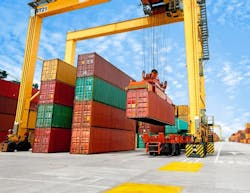How Tire Suppliers Are Coping with Supply Chain Issues
How are tiremakers and other tire suppliers helping to ensure good fill rates for dealers during the ongoing shipping crisis?
“We continue to monitor challenges in the supply chain very closely and so far we have not seen any significant impact to our business,” says Will Robbins, director of consumer product strategy, Bridgestone Americas Inc.
“Bridgestone is fortunate to have a diverse supply chain that includes both domestic and global manufacturing. There are challenges for sure and supply is tight, but we are confident in our ability to meet our customers’ needs.”
Josh Simpson, senior vice president, proprietary brands, for American Tire Distributors Inc., says the company is "not immune to delays from overseas and shipping challenges, in general. There have been delays for all manufacturers that are importing products into the U.S. due to shortages of containers and extended lead times. However, we continue to work through them and provide our dealers with products.”
John Hagan, executive vice president of sales for Nexen Tire America Inc., says Nexen is “looking for the best possible ways to get tires to our customers every day in the most economical way possible.”
Christy McDaniel, head of supply chain for Nokian Tyres plc’s North American business, says the “steady increase in domestic production at our North American factory in Dayton, Tenn., has helped us reduce our reliance on global supply. And the facility will especially pay dividends once it reaches full capacity in the coming years. The factory also reduces shipping lead times and allows us to align production with North American demand.”
Nokian recently moved to an expanded distribution center in the Chicago, Ill., market “to better accommodate the rising domestic volume we’re seeing” and is planning to set up a new warehouse at the company’s Tennessee plant.
Pirelli Tire North America Inc. officials characterize shortages and supply chain disruptions as “significant. Pirelli is working closely with customers on an integrated approach to ensure that they are prepared in this environment. “We are using levers - such as collaborative forecasting, made-to-order productions and stock data sharing - to maximize availability and sales.
“In order to evade inflation and high terminal congestion on local distribution, we have combined the approach with customers based on delivery optimization and a cost-saving sharing model to not compromise premium service.”
“It seems as if logistics, in general, are continuing to get more and more difficult,” says Nick Gutierrez, sales director, Sentury Tire USA. That includes securing space on vessels “at competitive rates.
“Lots of contracted rates continue to exist, but are being outweighed by spot market purchasing. We continue to fulfill our business partners from factory-direct and work together on current container shipping options. We also have two U.S. warehouses that help fill current and future voids.”
Jenifer Golba, senior vice president, consumer product marketing, TBC Corp., says TBC’s portfolio of domestically and internationally produced products allows “for a minimized risk of supply disruption. We have also proactively taken additional actions to assist with the reduced fill rates, such as improved days of sales coverage, increased order frequency, targeted, high-volume SKUs” and streamlined forecasting.
“In March, we launched a logistics intelligence system that provides access to more inventory through different points of distribution, offering our customers visibility to more tires.
“Recently, we launched a just-in-time delivery option to meet our dealers’ demand of increasing SKU complexity and speed, offering delivery within two hours or less for dealers in a 35-mile radius. We have also increased our collaboration with dealers providing digital integration.”
Tireco Inc. is using its network of distribution centers “and longstanding relationships with our overseas carriers to optimize our product flow to best support our customers,” says Andrew Hoit, the company’s vice president of sales and marketing. “We expect the next nine months to continue to be challenging, but we are confident in our partners and our ability to provide” optimal fill rates.
Joaquin Gonzalez Jr., president, Tire Group International LLC (TGI), says the “reality is (that) no one could have anticipated the escalation of freight rates - as well as the shortage of equipment - we are facing.
“Freight rates are up over 500%, and the most frustrating part - even if you pay the market rate for certain lanes - is you are not guaranteed a booking. In my 25-plus years in the business, I have never seen anything like it.”
TGI is dealing with the situation “as best we can. We prioritize shipments, as well as find alternate lanes that may provide additional booking confirmations. We have also increased our inventory reserves at all our distribution centers to have better availability as transit times become longer.”
Brian Fjeldsted, vice president of marketing at Vogue Tyre & Rubber Co. says Vogue, “like many in the industry, (is) faced with shipping and logistics challenges. We are facing these challenges by being as transparent and accurate in our communications with our customers.
“We have established new processes and ongoing reporting to better forecast when products will be available, so that our customers can better manage their clients’ expectations. Our regional managers are having, at a minimum, weekly conversations with our wholesale partners on product shipping updates. Finally, internally, we have better organized our warehouses and procedures to turn products as fast as possible to our customers.”
“In the dynamic situation of ever-evolving challenges for worldwide logistics, we are focusing on increasing communication with our customers to keep their priorities at the forefront,” says Drew Dayton, senior product planning manager, Yokohama Tire Corp.
“Our logistics team is investigating every opportunity to maintain our supply from factory to customer in the quickest, most efficient manner. That’s why we just opened our fourth distribution center in the U.S., a new 430,000 square-foot facility in Wilmer, Texas.”
The warehouse is located 15 miles from Dallas.
